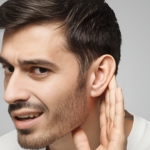Did You Know Learning Hearing Impaired Signs Language Can Help People with Hearing Loss? Improve Communication with ASL and More
Whether you work in healthcare, are a family member, or just want to learn more, now is a great time to start. You’ll open doors to the deaf community and improve your communication skills.
For those dealing with tinnitus and other hearing-related issues, there are solutions available that promise no more whooshing, buzzing, and clicking, while improving brain function and offering 20/20 hearing. Discover more about this incredible solution here.
Key Takeaways
- ASL is a complete, natural language with its own grammar and linguistic properties, distinct from English.
- Mastering sign language can enhance communication and inclusivity for individuals with hearing loss.
- Avoid using the term “hearing impaired,” as it is considered derogatory within the Deaf community. Instead, use “Deaf” or “Deaf/Hard of Hearing”.
- Learning sign language requires practice and immersion, but various resources are available to make the process accessible and enjoyable.
- Clarity and precision are more important than speed when communicating through sign language.
What is American Sign Language (ASL)?
American Sign Language (ASL) is a complete, natural language. It has the same structure as spoken languages. It uses hand and face movements to communicate.
Many North Americans who are deaf or hard of hearing use ASL as their primary language.
ASL as a Natural Language
ASL has all the basic features of language. It has its own rules for how words are formed and arranged. This is similar to spoken languages.
Studies show that signing complex phrases uses the same brain areas as speaking. This proves that ASL is a natural language.
Over half a million people in the US use ASL as their native language. It’s the third most common language in the country, after English and Spanish. There are over 300 signed languages worldwide, showing the diversity of natural languages beyond spoken ones.
For those who are also dealing with tinnitus, improving hearing and brain function is possible. Learn more about solutions that can enhance your quality of life here.
Lip reading is sometimes used by the deaf community. But it’s not effective for two-way communication. It takes years to master.
Sign languages like ASL offer a natural way for the deaf and hard of hearing to communicate. They allow for meaningful conversations and expression.
Diversity of Sign Languages Around the World
The world is full of different sign languages, showing the richness of Deaf cultures everywhere. There is no single sign language used everywhere. Each country or region has its own, like British Sign Language (BSL) and American Sign Language (ASL), which are very different.
Some sign languages mix in elements from ASL but keep their own special touches. For example, today’s ASL combines the original local signs with bits from French Sign Language (LSF). This mix makes ASL a complex, grown-up language. The variety in sign languages shows the lively cultural identities of Deaf communities all over the world.
| Sign Language | Region | Approximate Number of Users |
|---|---|---|
| American Sign Language (ASL) | United States and Canada | 500,000 to 2 million |
| British Sign Language (BSL) | United Kingdom | Estimated 150,000 users |
| Indian Sign Language (ISL) | India | 1 million to 2.7 million |
| French Sign Language (LSF) | France | Approximately 100,000 users |
The variety of sign languages worldwide shows the rich cultural heritage of Deaf communities. From the famous ASL to the less known local signs, each sign language is special. It shows the unique needs and identities of the local Deaf people.

It’s hard to say exactly how many sign languages there are globally. But, it’s thought there are over 300 different ones in use today. This variety shows how adaptable and strong Deaf communities are. They’ve found creative ways to communicate and keep their cultural identity alive.
hearing impaired signs language
For those who are hearing impaired, sign language is a key for talking and connecting. The “hearing impaired” sign is well-known, involving a gesture to the ear and then signing “INTERRUPT.” Yet, the term “hearing impaired” is seen as offensive by many in the deaf community. Instead, they prefer “Deaf” or “Deaf/Hard of Hearing.”
The U.S. Census Bureau says American Sign Language (ASL) is the third most used language in the U.S. This shows its importance and wide use in the deaf world. Sign language is not just for talking; it’s also a way to keep deaf culture alive and strong.
| Terminology | Preference |
|---|---|
| “Hearing Impaired” | Derogatory and unacceptable |
| “Deaf” or “Deaf/Hard of Hearing” | Preferred and respectful |
It’s key to know and respect the deaf community’s language choices. By using the right words and learning sign language, we can make places more welcoming for deaf and hard of hearing people.
The variety of sign languages worldwide, like Mexican Sign Language and British Sign Language, shows how rich and meaningful sign language is. By learning more about sign language, we support the deaf community’s rights and understanding.
Importance of Early Language Exposure
Early language exposure is key, even more so for kids with hearing issues. A study by Snoddon (2008) found that American Sign Language (ASL) and early help lead to better outcomes. This shows how vital early language skills are for deaf kids’ minds and social growth.
Early Language Acquisition for Deaf Children
Deaf kids need to start learning a language early, whether it’s spoken or signed. The first years are critical for building strong communication skills. A study by Niparko et al. (2010) looked at spoken language after cochlear implants. Geers et al. (2017) showed that sign language early on can boost cochlear implant benefits.
About 9 out of 10 deaf kids have hearing parents. These parents often struggle to pick the right way to communicate with their child. This can limit their child’s exposure to the deaf culture. Barnett et al. (2011) pointed out health disparities among Deaf sign language users, stressing the need for fairness in health care.
| Key Findings | Researchers |
|---|---|
| ASL and early intervention were linked to positive outcomes for hearing-impaired individuals. | Snoddon (2008) |
| Focused on spoken language development in children post-cochlear implantation. | Niparko et al. (2010) |
| Early exposure to sign language can enhance the benefits of cochlear implantation. | Geers et al. (2017) |
| Highlighted health inequities faced by Deaf sign language users, emphasizing the need for social justice in public health. | Barnett et al. (2011) |
The studies show how crucial early language, whether spoken or signed, is for deaf kids. If you’re dealing with hearing loss or tinnitus, finding the right solution early can also have significant long-term benefits. Explore how this solution can improve your hearing and brain function here.
Conclusion
Learning sign language is a transformative experience that enhances communication, cognitive abilities, and inclusivity. It opens up new opportunities for connecting with the Deaf community and helps bridge communication gaps.
Research has shown that early exposure to sign language is especially beneficial for children with hearing loss, fostering stronger language development. If you’re a parent, a healthcare professional, or simply someone interested in learning sign language, now is the time to start. Additionally, innovative solutions for improving hearing and brain function, like the one found here, can significantly enhance your quality of life.
By embracing sign language, you not only learn a new skill but also contribute to a more inclusive and understanding world. Whether for personal growth or to help someone with hearing loss, the benefits of sign language are vast and impactful.
Check out This Post: https://healthsuccesful.com/choosing-the-right-ear-protection-for-concerts-and-events/
FAQ
What is American Sign Language (ASL)?
American Sign Language (ASL) is a full language, like spoken ones. It uses hand and face movements. It’s mainly used by many deaf and hard of hearing people in North America.
What is the sign for “hearing impaired”?
The sign for “hearing impaired” is pointing to your ear and then signing “INTERRUPT”. But, it’s better to use “Deaf” or “Deaf/Hard of Hearing” instead. These terms are more respectful in the Deaf community.
What are the preferred terms for referring to individuals who are deaf or hard of hearing?
“Hearing impaired” is not a good term. Instead, use “Deaf and Hard of Hearing” or just “Deaf”. These are the respectful and preferred terms.
How important is early language exposure for deaf or hard-of-hearing children?
It’s very important to expose deaf or hard-of-hearing kids to language early. This helps with their language, thinking, and social skills. The first years are key for language development, and even early months matter for communication with caregivers.
What is the diversity of sign languages around the world?
There’s no single sign language worldwide. Each country or region has its own. For example, British Sign Language (BSL) is different from ASL. Americans who know ASL might not get BSL.
Some countries mix ASL with their own sign languages. Today’s ASL has French Sign Language (LSF) and local sign languages. This mix has made ASL a rich and complex language.
Source Links
- Literacy and Deaf / Hard of Hearing – https://deafandblindoutreach.org/literacy-and-deaf-hard-of-hearing/ASL
- NAD – Learning American Sign Language – https://www.nad.org/resources/american-sign-language/learning-american-sign-language/
- American Sign Language – https://www.nidcd.nih.gov/health/american-sign-language
- American Sign Language | Commission on the Deaf and Hard of Hearing (CDHH) – https://cdhh.ri.gov/information-referral/american-sign-language.php
- Deaf Culture and Sign Language | ALTA Language Services – https://altalang.com/beyond-words/deaf-culture-and-sign-language/
- The Diversity of Sign Languages: A Global Linguistic Tapestry – https://www.linkedin.com/pulse/diversity-sign-languages-global-linguistic-tapestry-siggnn
- Discover just how diverse sign language is | True Colors Festival – https://truecolorsfestival.com/voice/sign-language-is-diverse/
- Sign Language and Its Importance for the Hearing Loss Community — Hearing Health Associates – OFFICIAL WEBSITE – https://www.hearinghealthassoc.com/hearing-health-associates-va-blog/sign-language-and-its-importance-for-the-hearing-loss-community
- Deaf Communication: Sign Language and Assistive Hearing Devices – https://www.disabled-world.com/disability/types/hearing/communication/
- Deaf culture: what is it, history, aspects, examples & facts – https://www.handtalk.me/en/blog/deaf-culture/
- Education and health of children with hearing loss: the necessity of signed languages – https://www.ncbi.nlm.nih.gov/pmc/articles/PMC6796673/
- The impact of early language exposure on the neural system supporting language in deaf and hearing adults – https://www.ncbi.nlm.nih.gov/pmc/articles/PMC7985620/
- Early exposure to sign language: An advantage to parents and children | Aussie Deaf Kids – https://www.aussiedeafkids.org.au/resources/language-and-communication/australian-sign-language/early-exposure-to-sign-language/
- The Benefits of Sign Language for Children with Hearing Loss – https://www.handtalk.me/en/blog/the-benefits-of-sign-language-for-children-with-hearing-loss/
- What you don’t know can hurt you: The risk of language deprivation by impairing sign language development in deaf children – https://www.ncbi.nlm.nih.gov/pmc/articles/PMC5392137/
- Language acquisition for deaf children: Reducing the harms of zero tolerance to the use of alternative approaches – Harm Reduction Journal – https://harmreductionjournal.biomedcentral.com/articles/10.1186/1477-7517-9-16



